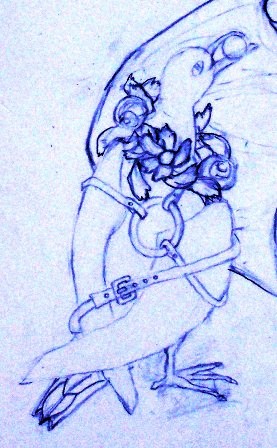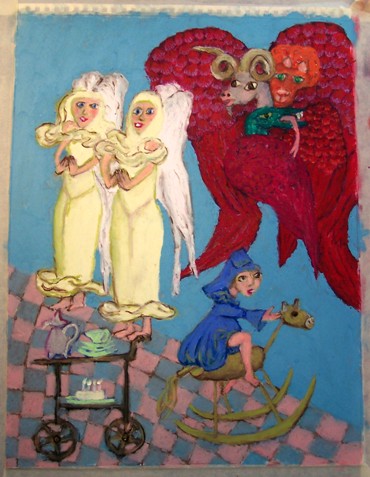Mood:
Topic: art in progress
Just finished. Took pictures this morning. Very difficult to capture the look of the original. This is an oil painting done on paper mounted on board. It measures (I'll have to get back to you).
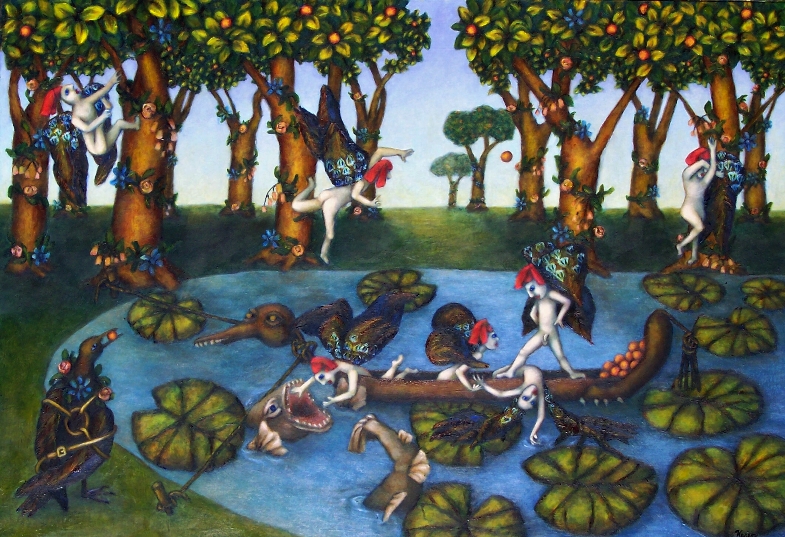
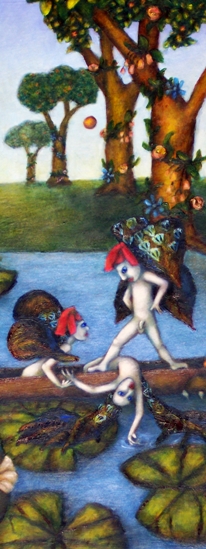

| « | June 2006 | » | ||||
| S | M | T | W | T | F | S |
| 1 | 2 | 3 | ||||
| 4 | 5 | 6 | 7 | 8 | 9 | 10 |
| 11 | 12 | 13 | 14 | 15 | 16 | 17 |
| 18 | 19 | 20 | 21 | 22 | 23 | 24 |
| 25 | 26 | 27 | 28 | 29 | 30 | |



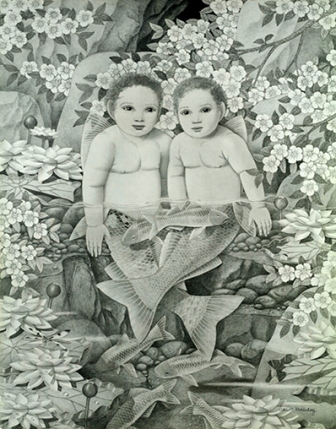 Yesterday I found an interview with Aaron Holliday, the schizophrenic painter I admire who painted "Baby Fish". I felt sad for Holliday because he took the same gamble that I am taking, trying to stand on his own two feet an make money as an artist. It backfired when he lost his social security income. Now he has no medical care for the schizophrenia and that is a very dangerous position to be in. The disease can be progressive, with psychosis worsening and brain damage resulting in an even lower level of artistic productivity. Un-medicated it is possible that he could lose that ability to make art for several years or even, forever. Somebody has to talk straight to Holliday about the severity of his illness and what he needs to do to defend his gift and his sanity. Somebody needs to say things that would break his heart, I bet that none of his caretakers has the guts to do it.
Yesterday I found an interview with Aaron Holliday, the schizophrenic painter I admire who painted "Baby Fish". I felt sad for Holliday because he took the same gamble that I am taking, trying to stand on his own two feet an make money as an artist. It backfired when he lost his social security income. Now he has no medical care for the schizophrenia and that is a very dangerous position to be in. The disease can be progressive, with psychosis worsening and brain damage resulting in an even lower level of artistic productivity. Un-medicated it is possible that he could lose that ability to make art for several years or even, forever. Somebody has to talk straight to Holliday about the severity of his illness and what he needs to do to defend his gift and his sanity. Somebody needs to say things that would break his heart, I bet that none of his caretakers has the guts to do it.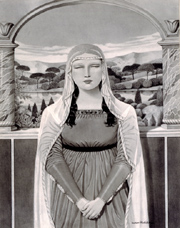 The Art of Aaron Holliday
The Art of Aaron Holliday Many of Mr. Holliday's pencil drawings feature an eagle and a Native American character. In one, the eagle is soaring above mountains and a stream, with the full span of the bird's wing illustrated. In another, "Yellow Hawk", the bird is perched atop the outstretched arm of the Native American man with a forest backdrop The man is wearing long braids and a feather. Like all of Mr. Holliday's other works, these are finely detailed.
Many of Mr. Holliday's pencil drawings feature an eagle and a Native American character. In one, the eagle is soaring above mountains and a stream, with the full span of the bird's wing illustrated. In another, "Yellow Hawk", the bird is perched atop the outstretched arm of the Native American man with a forest backdrop The man is wearing long braids and a feather. Like all of Mr. Holliday's other works, these are finely detailed.
 When they told me their plan I begged them for one more chance to make enough of a recovery that I be discharged to a half-way house. The hospital's criteria for wellness was that I cease being continuously suicidal and that I obtain and keep a part-time job outside of the Institute walls. Perhaps, then, an angel came to look over me for I was able to obtain a job at a prestigious world class museum in downtown Hartford, The Wadsworth Atheneum. At the interview for a position at the museum information desk, I was frank about my situation. I would walk from the Institute to the Wadsworth and then walk back home where I would be locked again on a psychiatric unit. The woman who would become my boss hired me. At first the job was volunteer, with the possibility of paid employment in the future.
When they told me their plan I begged them for one more chance to make enough of a recovery that I be discharged to a half-way house. The hospital's criteria for wellness was that I cease being continuously suicidal and that I obtain and keep a part-time job outside of the Institute walls. Perhaps, then, an angel came to look over me for I was able to obtain a job at a prestigious world class museum in downtown Hartford, The Wadsworth Atheneum. At the interview for a position at the museum information desk, I was frank about my situation. I would walk from the Institute to the Wadsworth and then walk back home where I would be locked again on a psychiatric unit. The woman who would become my boss hired me. At first the job was volunteer, with the possibility of paid employment in the future.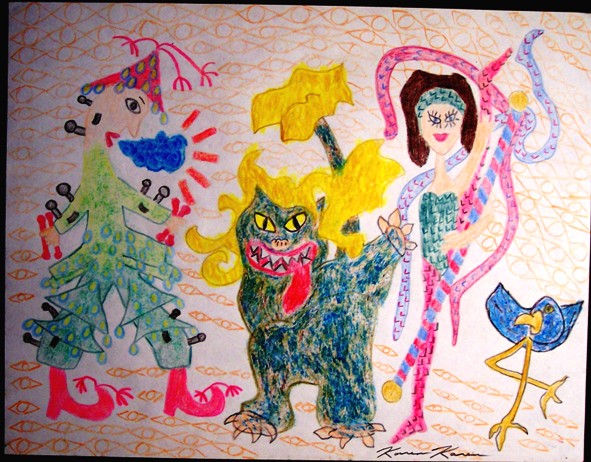 I also remember the art projects that I did on my own when I was in the hospital. Here is a drawing I made with colored pencils of three performers in a circus. You can get very board while you are locked up. I liked keeping busy. And look at the fun and curious world I got to escape to! I remember where the orange double triange and circle pattern came from. When I was first admitted because I felt suicidal my mind was so fragmented that all I could draw was the repetition of the triange and circle pattern. It made what looked like a row of eyes. I filled sheets of paper from top to bottom with the one pattern. I did this activity because there was no other activity my mind could do at that time.
I also remember the art projects that I did on my own when I was in the hospital. Here is a drawing I made with colored pencils of three performers in a circus. You can get very board while you are locked up. I liked keeping busy. And look at the fun and curious world I got to escape to! I remember where the orange double triange and circle pattern came from. When I was first admitted because I felt suicidal my mind was so fragmented that all I could draw was the repetition of the triange and circle pattern. It made what looked like a row of eyes. I filled sheets of paper from top to bottom with the one pattern. I did this activity because there was no other activity my mind could do at that time.
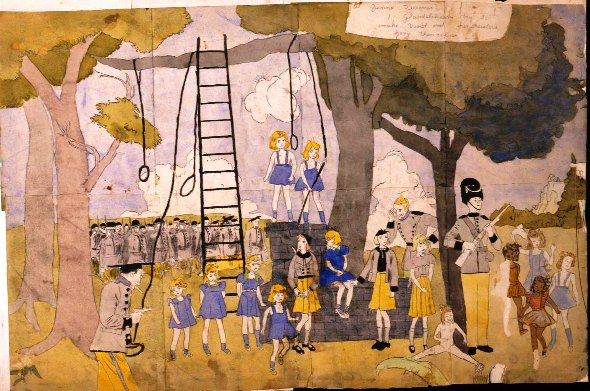
I have long been familiar with the artwork of Henry Darger which depicts little girls in similar violent situations. The Darger illustration above was located by me on the internet and I have never seen it before. Never did I desire to imitate Darger with my orange tree grove. Currently my Henry Darger book is lent to a friend. All I can say is that I must be as mentally disturbed as that man was. Truthfully, one of the symptoms of my illness is a desire to kill myself or the belief that I ought to be killed. The main difference between Darger and I is that he was an artist working entirely in private, all his art and writing was discovered after death. He was a recluse with no reason for self censorship. But I, being far more connected to family and society, have to temper some artistic impulses. The violence never completely goes away, it rather becomes sublimated into images that can have a multiplicity of interpretation. An example would be the playful throwing of an orange, rather the way a snowball is thrown by children. Except I think that if the throw was hard and fast and if you got hit that would sting and bruise your body quite a bit.
As I mentioned, I often see pictures in my head. It occurs entirely in my imagination and I have never hallucinated. If I want I can change the picture in my head, experiment with a different color or style of dress. Part of the allure of making art is the summoning of these pictures, it is quite comforting, and like having an imaginary playmate, they are good company.
Perhaps I should make a final note about my awareness of the Outsider art and Visionary art movements. These are contemporary terms that could be used to describe my art. Instead of getting into a discussion of why I may qualify for one category or the other, I will admit that my library contains only a few examples of such artwork. Maybe part of the problem is that I get too excited by seeing artwork that is similar to my own. Or maybe I am jealous of reading about artists who are now recognized by the art world while I am not.
There was a time when my library contained books about this type of art. I think I donated those books to a charity during a move from one apartment to another. By reading books and magazines such as "Raw Vision" I became aware that the boundaries of definition of style and talent were more flexible than anything I knew before. I became aware that I am not a freak and that it is acceptable by some to make untutored nonacademic primitive pictures. But I think that artists who are like me do not inspire me because in their work there is no mystery. I like to look at artists who can do things that I cannot. I like looking at artists who make me ask, "How did he do that?" and "What made him want to do that?" Similarity is also dangerous because I don't want to copy, steal a bit maybe, but never ever copy. I like to look at artists who are better than me, and perhaps, because of their healthy minds and academic training and social connections can make art that I will never be capable of making.
The best source of inspiration is often nothingness. In such times of nothingness the only thing to do is to summon a dream. Such inspiration won't be easy - dream logic occurs when we sleep for a reason. There are boundaries that thought is adverse to cross over. And don't ever become too attached to what has been done before or what is being done right now. The path to being an individual carries the most grief and mental resistance, it is so much easier to be part of a group than to be isolated and self-reliant.
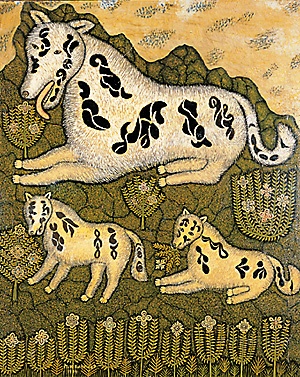 What are the artists you admire?
What are the artists you admire?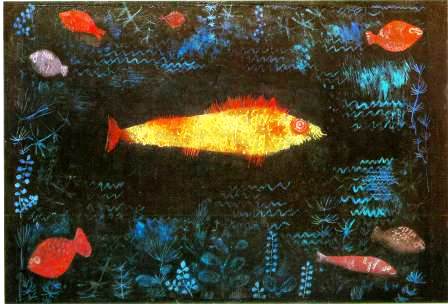
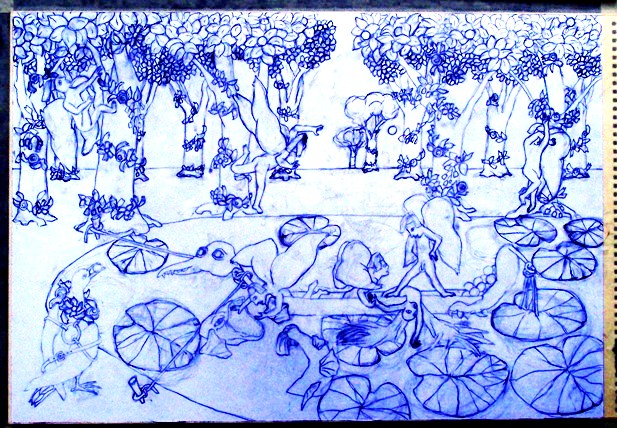
Originally I wanted angels hanging from every tree. Hanging by rope wrapped round their necks dead. I also wanted one angel to be holding the head of another angel under water, drowning the second.
I kept such impulses under control.
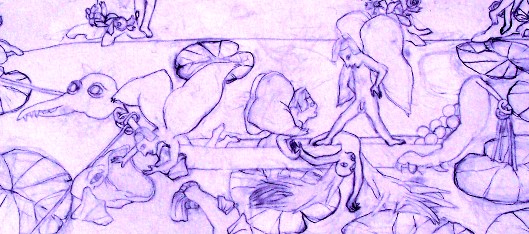
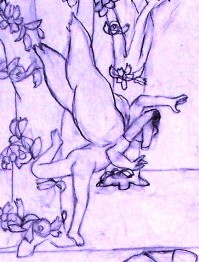 So when you see play in the drawing, is it mildly dark and violent?
So when you see play in the drawing, is it mildly dark and violent?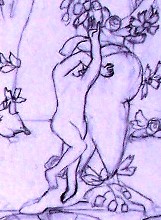
This is a self drawing. The bird bound by leather straps is me.